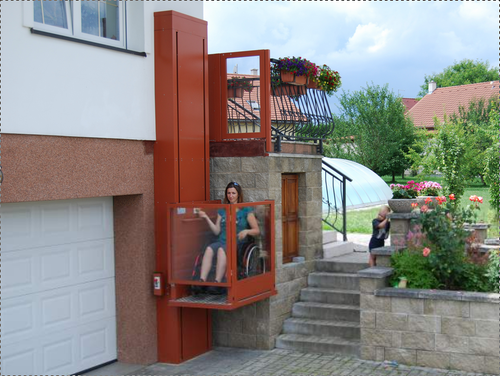Although you may hear the phrases “access lift” and “platform lift” used frequently, there are distinctions between the two. In addition, despite their many commonalities, platform lifts and access lift vary in several features.
In the sections below, we’ll go through the specifics of these two mobility solutions, along with a few typical representations of each and its most distinguishing features.
Vertical Platform Lifts
Vertical Platform lifts, sometimes referred to as wheelchair lifts, are stand-alone units intended to allow access in places where an elevator would’ve been either impossible or impracticable to build.
Essentially, vertical platform lifts are intended for people in wheelchairs who need to go from one level to another at home or the workplace.
It consists of a lift tower, a set of controls, and a platform that can be mounted either indoors or outdoors.
Moreover, these lifts can only go a set vertical distance, generally about 12 feet, and must make a few pauses along the route. Many people prefer to install vertical platform lifts in their homes, schools, and offices rather than a ramp, which may not be viable because of structural limitations.
Furthermore, vertical platform lifts can help individuals get across minor architectural obstacles like stages, staircases, and porches. Likewise, vertical platform lifts may be installed in either a fixed or transportable arrangement, unlike access lifts.
Access Lifts
Access Lifts take up much room to build because they need a shaftway to contain the lifting mechanisms. Therefore, access lifts are less common in smaller facilities and private residences with this space demand.
On a lighter note, access lifts also have a considerable load capacity, making them ideal for simultaneous passenger and freight transport. Ideally, the capacity of an access lift is generally between 5 to 25 persons. However, the maximum capacity hand is determined by the size and needs of the structure.
Nonetheless, many commercial establishments such as a hotel, office, or apartment complex use an access lift to move passengers in a high-rise structure from one level to another.
On the other hand, a residential access lift provides additional design and construction alternatives, as well as a quicker and more efficient way of accessing multiple floors of your house. Residential access lifts are a logical mobility solution in larger residences or multi-family homes.
In summary, we can say that access lifts and vertical platform lifts differ in the following attributes:
Vertical platform lifts
- Users can install it permanently or removable.
- Use by a single passenger with a temporary or permanent disability; and
- Limited weight and rise capacities
Access Lifts
- Permanently installed, often in high-rise structures with several storeys.;
- Built to handle several people or oversized loads and
- have to take up a sizeable proportion of space
When thinking about what mobility solution to install in your home or commercial space, consider these distinguishing attributes. The right lift may spell the difference between ease of access, safety, utility, and aesthetics for both users and home or commercial space owners.
Visit the publisher AXESS2 for more information on which type of lift will suit you best according to your needs.
